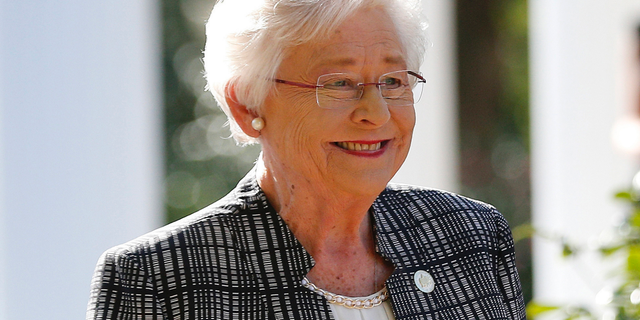
WASHINGTON
(AP) — President Donald Trump is warning that the country could be
headed into its “toughest” weeks yet as the coronavirus death toll
mounts, but at the same time he expressed growing impatience with social
distancing guidelines and said he’s eager to get the country reopened
and its stalled economy back on track.
“There
will be a lot of death, unfortunately,” Trump said Saturday in a somber
start to his daily briefing on the pandemic, “There will be death.”
Joining
Trump were Vice President Mike Pence, virus task force coordinator Dr.
Deborah Birx, and Dr. Anthony Fauci, the U.S. government’s foremost
infection disease expert. Each stood far apart from one another on the
small stage.
ADVERTISEMENT
Trump
added a twist on his familiar push for a drug that hasn’t been clearly
shown to work to stop the virus — he said he may start taking it as a
preventative measure after consulting with his doctor, even though
there’s no evidence to show it works for that, either.
The president initially had suggested the country could reopen by Easter but pulled back seeing projections of
a staggering death toll even if restrictive measures remain in place.
But just days after extending tough national guidelines through the end
of April, staring down historic levels of unemployment
and economic standstill, he was talking about reopening as soon as
possible, and speaking Saturday with leaders of professional sports
leagues about filling arenas again.
“This country was not designed to be closed,” he said. “The cure cannot be worse than the problem.”
The
number of people infected in the U.S. has exceeded 300,000, with the
death toll climbing past 8,400; more than 3,500 of those deaths are in
the state of New York. For most people, the virus causes mild or
moderate symptoms, such as fever and cough that clear up in two to three
weeks. For some, especially older adults and people with existing
health problems, it can cause more severe illness, including pneumonia,
and death.
Much
of the country is under orders to stay home, including professional
sports leagues that were among the first to clamp down in the pandemic. Trump spoke by phone with top leaders including
Roger Goodell of the National Football League and the NBA’s Adam
Silver, telling them he hoped to get people back in seats as soon as
possible.
“I want fans back in the arenas,” he said. “Whenever we’re ready, as soon as we can.”
The
virus has decimated the sports world with the National Basketball
Association and the National Hockey League suspending their seasons
indefinitely and Major League Baseball postponing the start of its
season. The NCAA basketball tournament was also canceled; so were
college spring sports.
A
person with knowledge of the call said some of the commissioners
weren’t quite as optimistic as Trump because of the concerns raised by
public health officials but appreciated the president’s desire to give
people hope and fans a reason to be optimistic. The person requested
anonymity to discuss the private call.
California’s
Gov. Gavin Newsom, who has three NFL teams in his state, was asked if
he thought the NFL season would start on time in September. “I’m not
anticipating that happening in this state,” he said.
Hard-hit states were seeing cases rise. Trump suggested that some states were asking for more medical supplies than they really needed. He said the goal was to stay several days ahead of critical medical needs in each state.
“The fears of the shortages have led to inflated requests,” he said.
Louisiana officials have said New Orleans
is on track to run out of ventilators by next week. New York Gov.
Andrew Cuomo, whose state is at the epicenter of the national pandemic
with over 113,700 confirmed cases as of Saturday morning, has pleaded
for ventilators for days. New York is poised to get more than 1,100
ventilators from China and Oregon.
Health
officials did offer some hope that social distance measures were
working. Fauci said he saw the efforts in action as he went out for a
walk in Washington, D.C., and noticed people waiting six feet apart for
restaurant take out.
“As sobering and a difficult as this is, what we are doing is making a difference,” Fauci said.
But
even as Fauci urged Americans to be patient and let mitigation efforts
work, Trump said: “Mitigation does work. But again, we’re not going to
destroy our country.”
The previously booming economy had been among Trump’s biggest talking points as he heads into the 2020 presidential election, but the past few weeks have seen precipitous drops
as the U.S. deals with the fallout from the virus that has shuttered
businesses, gutted airlines and forced people into their homes.
The president also continued to tout hydroxychloroquine,
a drug long used to treat malaria, rheumatoid arthritis and lupus,
after very small preliminary studies suggested it might help prevent the
coronavirus from entering cells and possibly help patients clear the
virus sooner. But the drug has major potential side effects, especially
for the heart, and large studies are underway to see if it is safe and
effective for treating COVID-19.
Trump
suggested he may consider whether he should start taking the drug,
though he also said he’d ask his doctor first. Some studies are testing
whether hydroxychloroquine can help prevent infections in health care
workers, but none has suggested that others, such as the president,
should take it to prevent infection.
With
Congress away, House Speaker Nancy Pelosi pressed for the next aid
package to be ready for an April vote in a letter to House Democrats.
“We
must double down on the down-payment we made in the CARES Act by
passing a CARES 2 package,” she wrote about the just-passed $2.2
trillion bill, pushing for another additional unemployment benefits,
small business loans and direct payments to Americans.
___
AP Pro Football Writer Rob Maaddi in Indian Shores, Florida, contributed to this report.




















